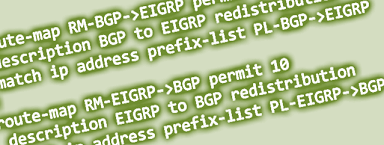
It’s said that you’re never to old too learn. I agree, and in fact it’s one of the things that has kept me in the networking industry for so long; there’s always something new going on to keep me interested.
And learn, I did, from a recent set of twitter interactions, some of which I’ll reproduce here in order to share the love with you all as well!
Route-Map Naming
I was browsing some old configurations (not mine, by the way) and came across a route-map which triggered the following tweet:

I am not, as you can tell, a fan of using numbers when a word will do just as well. Older readers will also recall that I like naming things sensibly. So take your “ROUTES4REDIST” prefix-list and bite my shiny metal rack post. One response to this tweet stood out to me though. Bob McCouch (@BobMcCouch) offered the following:

Old Dog, New Tricks
First of all, let’s take a moment to applaud Bob for being shameless enough to use a picture of him in his Cisco Live 2013 Orland CAE hat as his Twitter avatar. Bravo, sir! Spongebob McCouch, indeed. ![]() Anyway, I like this idea. I had no idea that you could use “>” in a route-map name, and indeed I don’t think I have ever seen it in a configuration.
Anyway, I like this idea. I had no idea that you could use “>” in a route-map name, and indeed I don’t think I have ever seen it in a configuration.
A couple of people said they had come across this while studying for an exam (maybe the CCNP Troubleshooting exam?). As Bob says, BGP->EIGRP seems pretty clear what it does. Of course, so is “BGP-TO-EIGRP”, but it doesn’t look quite as cute, does it? I guess it’s all preference, but it’s nice to have another reasonable option out there.
Why is this new to me though? I don’t know. Maybe it’s relatively new (I suspect not) or more likely it just isn’t commonly known. It appears to apply to both route-map and prefix-list names from what I can see too.
So there you have it. I learned something new, and I’m sharing it so that if you don’t already know it, you can learn it too!
If you liked this post, please do click through to the source at Never Too Old To Learn – Route-Map Naming and give me a share/like. Thank you!